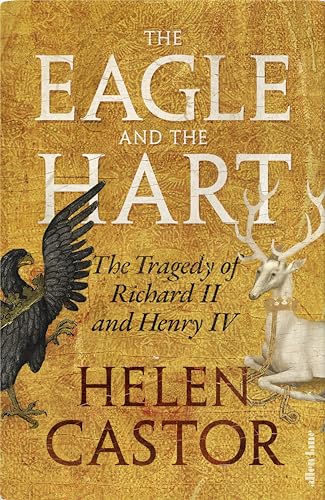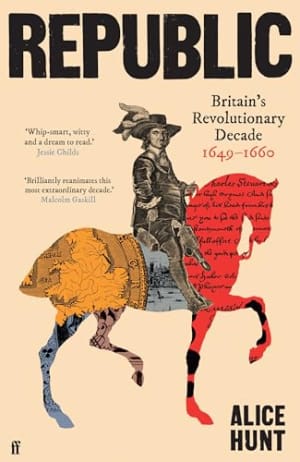This new book on Richard II and Henry IV, by Helen Castor (a former Cambridge fellow and TV broadcaster, specialising in English medieval and Tudor history) is a gripping drama of two closely connected but differing personalities who come into conflict: on one hand, the entitled, effete, and despotic Richard II; on the other, Henry of Bolingbroke, a model of manly medieval chivalry.
As the author describes it, Richard had none of the qualities required of a king, apart from one – birthright; Henry had many of the qualities of a good king but lacked the one that mattered the most - dynastic legitimacy. In the author’s own words ‘a king who was a tyrant was replaced by a king who was a usurper’.
Mano a mano
The author seeks to dig deep into the psychology of the two protagonists. Much of this is, inevitably, quite speculative (which the author herself admits in her introduction), but it does make for an entertaining read. This is one of the most well told rivalries in English history for good reason – Richard and Henry were closely related1 and had repeatedly entwined lives; but they differed markedly in personalities and, in some respects, the nature of the lives they lead.
Their rivalry is the stuff of great drama, something the author conveys powerfully.
Richard, the Hart
Richard loathed warfare, jousting, or any activity which might put his divine person in the way of physical harm, which was a problem for a medieval king, since the job description essentially involved killing Frenchmen. However, he did enjoy spending money on clothes, jewellery and home decoration, thinking up fitting epitaphs for himself, and lavishing titles and lands on his favourites.
The bad-tempered king
Richard also had a very bad temper – following one rebuke, he responded ‘If you are blaming me, if you say it is my fault that the realm is badly governed, you lie in your teeth. Go to hell!’. I may use that line myself next time someone upsets me.
Readers of this review in certain jurisdictions might feel like they know what it is like to have a tempestuous ruler. The problem for England at that time is that it had a much bigger and richer neighbour that was always willing to jump in and take advantage of periods of domestic instability (which worked both ways, of course – we did the same to the French when we got our act together and they were distracted).
Richard’s reluctance to get his hands dirty with fighting left the French free to ransack coastal towns in the south of England. I hadn’t quite appreciated how real the threat of invasion was felt to be at the time. At one point, the mayor of London ordered citizens to stockpile food in anticipation of a siege. Rather than fighting the French, Richard’s strategy involved marrying the daughter of the French king and asking, as part of the dowry, for military support against his own subjects should they ever rebel against him.
Henry, the Eagle
Henry was a man much more in the image of their shared grandfather, Edward III – militaristic, chivalric, and adventurous – his exploits abroad included crusades against pagans in Lithuania and a pilgrimage to Jerusalem – on his way there and back he became a bit of an international celebrity, hobnobbing with the kings of Bohemia, Hungary, and Cyprus, the Doge of Venice, the Grand Master of the Knights Hospitaller in Rhodes, and the Lord of Milan, where he established a long term attachment to the Gian Galeazzo’s young cousin, Lucia Visconti.2
Henry comes across as a complex character – certainly not the ‘ideal’ king which his grandfather, Edward III, embodied or which his heir, Henry V, would come to symbolise. Brought up in one of the richest aristocratic families in England, as king, Henry was spendthrift, overly loyal to his Lancastrian followers, and hamstrung by the enduring perception of illegitimacy which hung over his entire reign. But at least he was willing to listen to advice, consulate leading nobles and had a consciousness of his own fallibility, none of which could be said for Richard II. Overall, though, there is the pervading sense that his ‘original sin’ of deposition defined Henry, both to his contemporaries and to this day.
It is clear where the author’s sympathies lie, but whilst her take on Richard and Henry may not be original, it is difficult to fault – Richard appears to have few redeeming characteristics. But whilst he may have had few of the qualities of what we would consider a ‘good’ king, Richard had plenty of those required for an effective tyrant – in particular, an ability to instil a climate of terror among his leading citizens.
In contrast, the way in which Henry came to power appeared to embolden his nobles and parliament to challenge him at every turn. Throughout his reign, there is a sense that a whiff of illegality hung over him, which gave an opening to anyone who had any reason to feel dissatisfied with his reign to take liberties that they might not have done with Richard.
The Age of Bling
Richard’s reign was roughly contemporaneous with that of Philip the Bold as Duke of Burgundy, a key player in a book reviewed elsewhere on this site, The Burgundians; the theme of ‘bling’ is one that runs through both books. The author notes that Richard bought his queen a bejewelled band for a headdress which cost the equivalent of an average knight’s annual income. Ostentation seems to have been very much approved of at the time. Henry was not immune to this and was prone to a bit of conspicuous consumption himself – on the same day as he asked for loans to fund a war against Scotland, he spent £4503 on jewels and silver plate.
The right to rule
One the strongest themes which comes across in the book is just how important the idea of ‘legitimacy’ was to medieval kingship. Parliament and the nobility spent much of Richard’s reign doing rhetorical and constitutional gymnastics trying to get around the fact that Richard was an horrendous king.
When Henry did finally take the leap and usurp Richard, that deposition then haunted Henry, in his own mind and that of many of his subjects, for the remainder of his reign. The author notes that it remained so provocative almost two hundred years later, that the scene of the deposition itself was omitted from Shakespeare’s play when first published.
Likewise, when ‘The First Part of the Life and Raigne of King Henrie IIII’ by John Hayward was published in 1599, two hundred years after Henry deposed Richard, it ‘mightily incensed’ the then Queen, Elizabeth I, who had it banned and burned, and the author locked in the Tower of London.
Be careful what you put in your hair
The idea of legitimacy and the sacred were closely intertwined in the medieval mind. A medieval king was keen to make his coronation, and hence his kingship, as sacred as possible. That usually involved putting bits of oil on their heads. Richard was jealous that his contemporary, Charles, King of France, had been anointed with better oil than him – whilst Richard had to make do with run of mill holy oil mixed with fragrant balm, Charles had been anointed at his coronation with oil from the Holy Ampulla, a miraculous vial sent from heaven to Clovis, the first Christian king of France 900 years before.
Not wanting to be outdone, Richard later ‘discovered’ in the Tower of London a small crystal ampulla topped with a golden eagle which had been given by the Virgin Mary to St Thomas Becket two centuries earlier. Helpfully, a document found next to it explained in the saint’s own words that future kings of England must be anointed with the chrism it contained, and that ‘whenever a king wears the eagle on his breast, he will be victorious over his enemies, and his kingdom will always increase.’ Richard liked the sound of that.
Sadly, for Richard, the Archbishop of Canterbury refused to re-anoint him with it, insisting that a king could only be anointed once.4 Richard’s loss was Henry’s gain - after deposing Richard and locking him up in the Tower, Henry’s coronation used the new/old more sacred oil as a sort of holy salve to the taint of illegitimacy that hung over him, and by doing so one-upped his predecessor.
Unfortunately, for Henry, there was an awkward coda to this whole episode – a week after the coronation, the ceremonial removal of the cap which covered the site of his anointing revealed that the oil had left his hair crawling with lice and falling out. Perhaps the saint didn’t approve after all.5
Bob’s your uncle (or The Black Prince is your dad)
Sometimes when I read about English and French medieval history, I wonder whether it ever occurred to anyone at the time that there may have been downsides to subjecting a country to the lottery of hereditary rule. Whilst Richard was busy terrorising his Kingdom, France was dealing with a king who was so mentally impaired that he sometimes forgot who he was. ‘Good’ kings and ‘bad’6 seem to alternate with uncanny regularity. Might a better alternative have existed? The idea of the right to rule based on: (i) who your dad was; and (ii) the type of oil which was put on your head, is very persistent in this era. I would love to read a book which explains to me why that was.
What did I think about the book
The author, Helen Castor, is clearly an excellent storyteller. She has an instinctive grasp of what makes the rivalry of Richard and Henry compelling and resonant. She successfully finds the balance between, on one hand, a dry academic tome, and, on the other, a purely literary treatment of the story, by looking at what happened, what was written, and what was said, and drawing reasonable inferences from those about what might have been going through the minds of the Richard and Henry at the time.
In doing so, there is, inevitably, a fair amount of speculation that is open to dispute (as the author herself concedes). And the author’s take on the Richard and Henry story is, in many respects, quite conventional (essentially, Richard as the ‘bad’ guy and Henry as the ‘good’ but ultimately tragic one). But I felt that I left this book with a sense of what Richard and Henry might have been like, and what might have motivated them, and for me that made this a very worthwhile read.
Was there anything I didn’t like
For me, the book had no particular faults. The author does what she does very well – tell a story and explain her interpretation of the personalities and motivations of the main players. The book does raise a lot of interesting questions, such as the one above about the appeal of hereditary kingship, but the extent to which those questions are explored in this book is limited.
If you’re looking for an immersion in the medieval mindset and how that mindset viewed issues of political and religious legitimacy, and how those interacted, this book provides plenty of material for pondering, but not so much in-depth analysis of the answers to the questions raised. That will have to wait for another book.
Conclusion
Although this a much-told story, it stands up to repetition in this excellent book, which conveys both the drama of the story, and the complexity and nuances of the personalities involved.
They were first cousins, i.e. they were both grandchildren of Edward III, Richard through his father, the Black Prince, and Henry through his father, John of Gaunt. ↩︎
Lucia Visconti was very taken with Henry, purportedly saying that if she could have become certain of becoming Henry’s wife, she would have waited for him ‘to the very end of her life. Even if she knew she would die three days after the wedding’. Instead, she ended up marrying the Earl of Kent. The Earl died young whilst fighting for Henry, and left Lucia with heavy debts. When Henry’s own health was failing, he ordered that her husband’s debts to the crown should be waived, and he bought her back some silver plate which her husband had pawned. ↩︎
The Bank of England’s inflation calculator tells me that this is equivalent to £420,342.60 today. ↩︎
Instead, Richard wore the vial around his neck. ↩︎
Although Henry didn’t take it personally – a big fan of the Becket cult, he and his wife were buried next to the saint’s shrine at Canterbury Cathedral. ↩︎
Although our idea of what makes a king ‘good’ or ‘bad’ may differ. ↩︎
Book details
(back to top)- Title -
The Eagle and the Hart : The Tragedy of Richard II and Henry IV
- Author -
Helen Castor
- Publication date -
October 2024
- Publisher -
Allen Lane
- Pages -
688
- ISBN 13 -
9780241419328
- Podcast episode -
Noble Blood: Miscalculations in the Court of Richard II (with Helen Castor)
- Podcast episode -
The Medieval Podcast: The Eagle and the Hart with Helen Castor
- Amazon UK -
- Amazon US -



